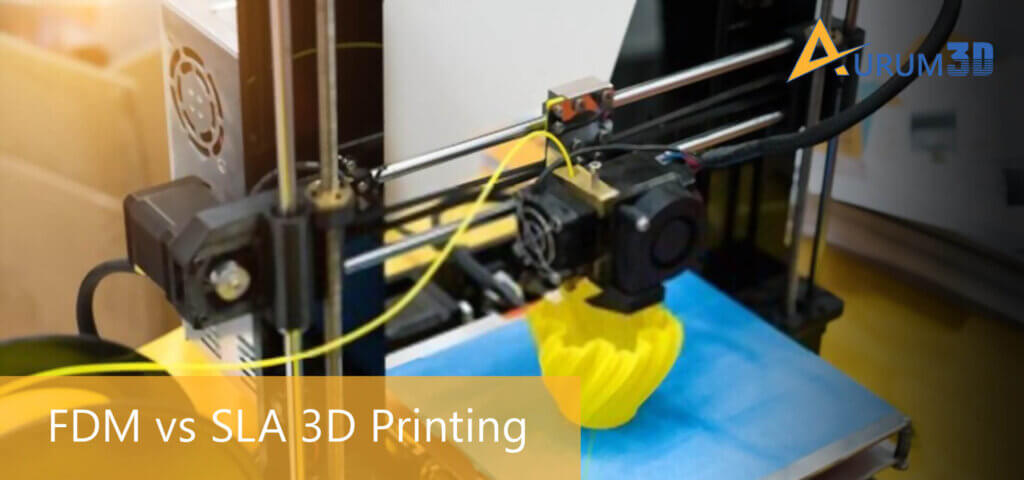You can use a 3D printer to build three-dimensional products, items, or objects physically from a digital file. The 3D printers create the physical objects or structures by depositing thin layers of materials successively. But you have the option to choose from a wide range of additive manufacturing or 3D printing technologies, including Fused Deposition Modeling (FDM) and Stereolithography (SLA).
Both FDM and SLA are widely used 3D printing technologies. SLA is an older and more mature form of 3D printing technology, while FDM is a relatively new additive manufacturing technology. Both 3D printing technologies produce physical objects and structures by depositing materials layer by layer. But they differ from each other in several aspects. You cannot choose the right 3D printing technology without asking some important questions.
What is Stereolithography (SLA) 3D Printing Technology?
According to Wikipedia,
“SLA is a form of 3D printing technology used for creating models, prototypes, patterns, and production parts in a layer by layer fashion using photochemical processes by which light causes chemical monomers and oligomers to cross-link together to form polymers.”
SLA is an earlier form of 3D technology. But it is still being used widely by individuals and enterprises across the world. SAL 3D printers produce three-dimensional objects or models by depositing material layer by layer. But they use ultraviolet (UV) laser beams to cure the photosensitive liquid resin. The UV beams transform the liquid resin into hardened plastic through a process called photopolymerization.
At present, SLA 3D printing technology is used by enterprises from various sectors to produce highly detailed prototypes. Many enterprises opt for SLA to build three-dimensional items with a smooth surface and finer features. They further experiment with various forms of resin to create objects with varying thermal, optical, and mechanical properties.
Now that you have got a basic idea about SLA 3D printing, now lets try and understand what is Fused Deposition Modeling.
What is Fused Deposition Modeling (FDM) 3D Printing Technology?
According to Technopedia,
“Fused Deposition Modeling (FDM) is a type of additive manufacturing technology that enables the construction of three-dimensional objects, prototypes and products through a computer-aided or driven manufacturing process.”
Fused deposition modeling (FDM) is also known as fused filament fabrication (FFF). FDM or FFF 3D printing technology produces a variety of three-dimensional objects or products by depositing thermoplastic layer by layer. The FDM 3D printers enable you to work with several types of thermoplastics. They are designed with a heated intruder which softens the thermoplastic as the material is being fed.
The softened thermoplastic filament is then deposited by the print head into the print area layer by layer. The DFM 3D printers produce three-dimensional items by depositing one layer at a time. Many people these days opt for FDM to 3D-print a variety of items at a lower cost. The durable and flexible nature of thermoplastics further helps users to customize and fine-tune the 3D-printed items using FDM printers. Here are the advantages of FDM 3D printing.
How Do SLA and FDM 3D Printing Technologies Differ from Each Other?
Materials
While using an SLA 3D printer, you have to use resin as the primary material. Resin is one type of light-reactive thermoset material. You have the option to choose from resin materials with varied formulation configuration. Hence, you can get the required thermal, mechanical, and optical properties by choosing the right type of resin. But you need to cure the resin filament using UV light to obtain hardened plastic.
At the same time, FDM printers produce three-dimensional objects using thermoplastic as the primary material. While using FDM 3D printers, you can choose from several types of thermoplastic – polylactic acid (PLA), acrylonitrile butadiene styrene (ABS), polyamides (Nylon), polycarbonate (PC), polyvinyl alcohol (PVA), and polyamides (Nylon). Also, you can customize the thermoplastic filaments by choosing the right blend and color. Here is an interesting read on 3D printing in ABS.
3D Printing Speed
As mentioned earlier, both FDM and SLA printers build three-dimensional items by depositing the filament layer by layer. But the layers created by FDM printers have a lower height than the layers created using SLA printers. That is why; SLA printers are about 5 to 10 times faster than FDM printers. The same object can be printed in about 9 hours using an SLA printer and about 80 to 90 hours using an FDA printer. That is why engineers prefer SLA printers to FDM printers to speed up prototyping and iterations.
3D Printing Cost
You have the option to choose from several models of FDM and SLA 3D printers. The models differ from each other in several aspects – size, features, performance, and cost. The prices of professional desktop FDM printers range from $2000 to $8000. At the same time, the prices of SLA 3D printers range from $3000 to $ 1000. Also, the thermoplastic filament used by FDM 3D printers is less expensive than the resin filament used by SLA printers. That is why; SLA 3D printers are used widely by engineers and enterprise users, while FDM 3D printers are hugely popular among students and hobbyists.
Build Volume
In 3D printing, the term build volume refers to the maximum size of the 3D-printed item. You have the option to use a 3D printer to create either a large component or multiple small components during a build. Each new version of FDM and SLA supports larger build volumes. Many 3D printers are designed with multiple extruders. The largest SLA printers these days support higher build volume than the largest FDM 3D printers.
Post Processing
An item 3D-printed using an FDM 3D printer can be removed from the print platform more easily and quickly than an object 3D-printed using an SLA printer. You need to use a palette knife to remove the object from the print platform. But you need to remove additional resin while removing the 3D-printed object from the print platform of an SLA 3D printer. Also, you can smoothen the surface of an item printed using an FDM printer through sanding. An item printed using an SLA 3D printer needs to be bathed in isopropyl alcohol to remove the sticky resin.
Print Quality and Reliability
SLA 3D printers score over FDM 3D printers in the categories of print quality and reliability. An SLA 3D printer cures the filament using laser beams. The laser beams make SLA 3D printing technology effective in bonding or connecting multiple layers fully and tightly. But FDM printers do not make multiple layers adhere to each other fully. Many engineers prefer SLA 3D printers to FDM 3D printers to achieve a higher level of reliability and precision. Also, SLA printers are used widely by enterprises for functional prototyping.
On the whole, both FDM and SLA are widely used 3D printing technologies. But they differ from each other in many aspects. Also, each of these popular 3D printing technologies has its own pros and cons. That is why; you must keep in mind the nature and requirements of the object or item to be 3D-printed while comparing FDM vs SLA 3D printing. You can always consider using FDM and SLA 3D printing technologies together by availing professional 3D printing services.
About Aurum3D
We, at Aurum3D, have been providing best in class FDM 3D printing services and SLA 3D printing services to our prestigious clients across the globe. You can get in touch with our solution experts to create a custom 3D printing solution tailor made for your business.

